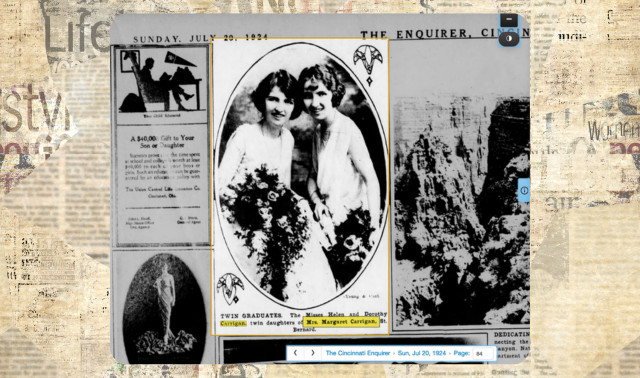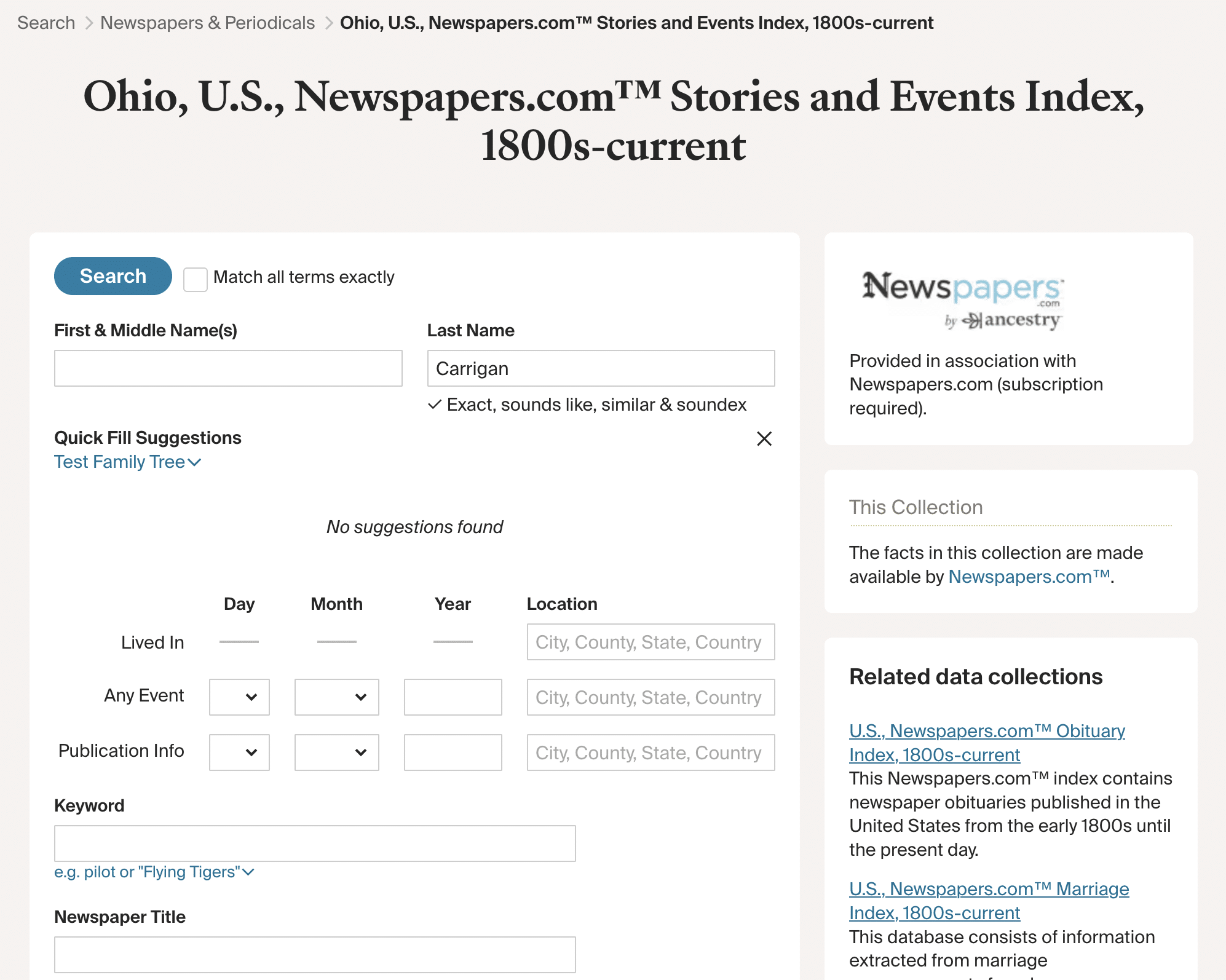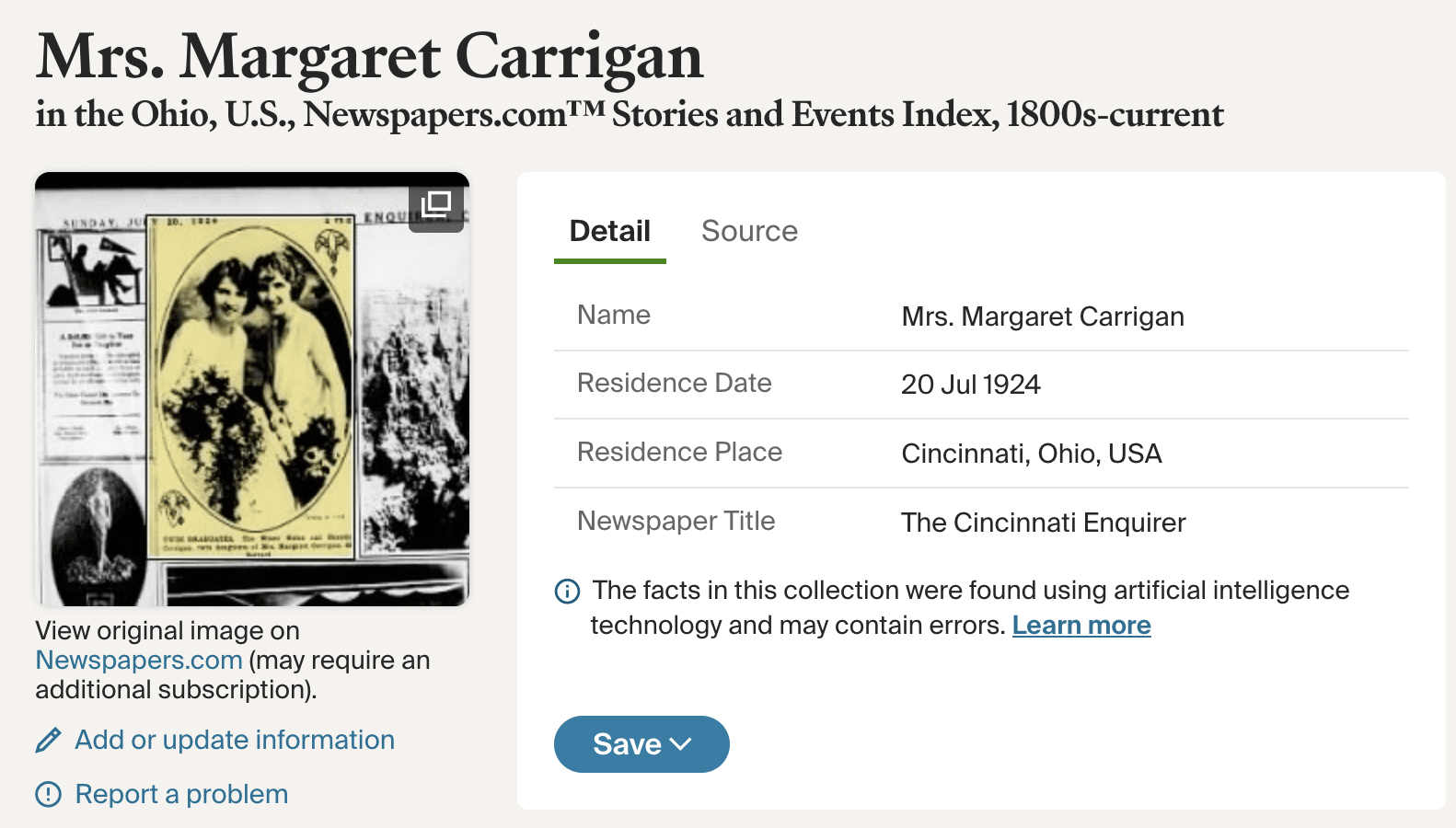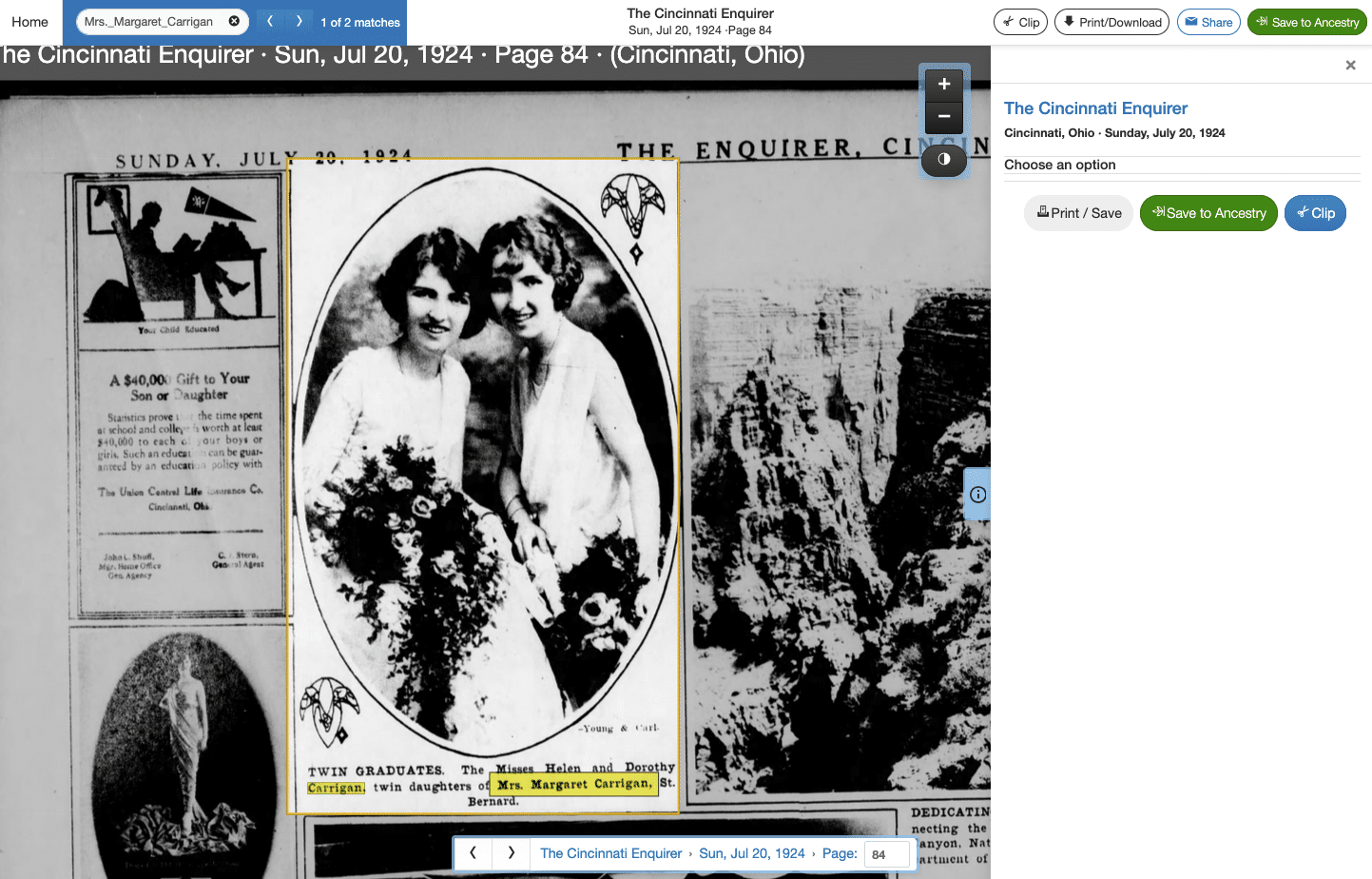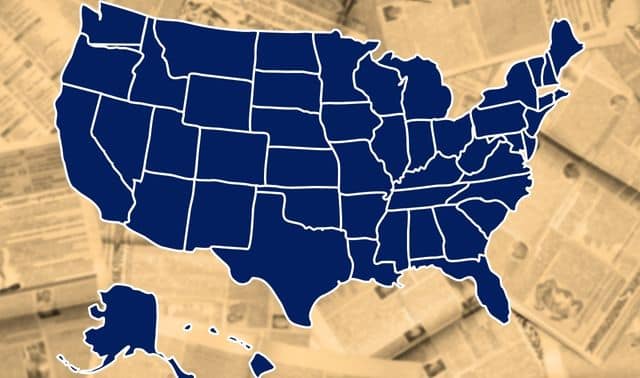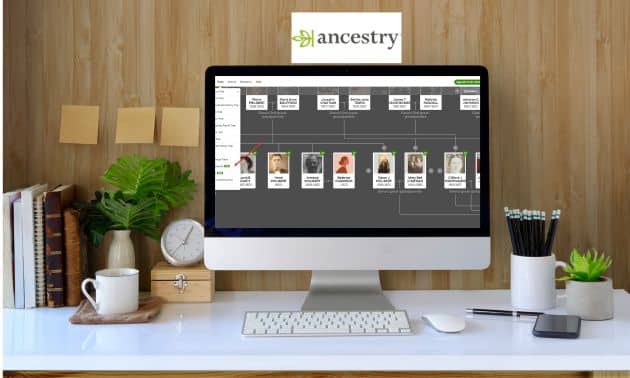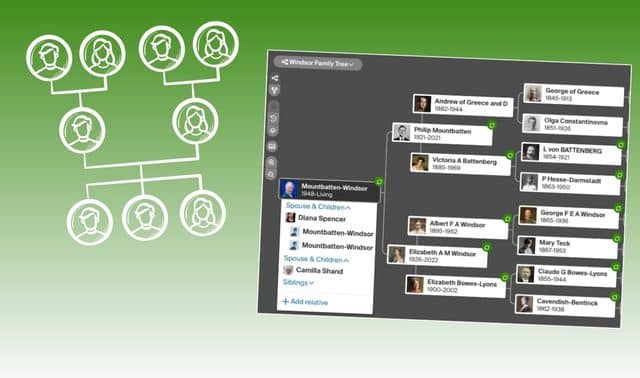Sign up for the Family Tree Newsletter! Plus, you’ll receive our 10 Essential Genealogy Research Forms PDF as a special thank you.
Get Your Free Genealogy Forms
"*" indicates required fields
Since 2022, megawebsite Ancestry.com has published massive collections of names extracted from digitized newspapers. For the first time, billions of data points from sister site Newspapers.com are keyword-searchable on Ancestry.com—not just from obituaries, but also from birth and death announcements, gossip columns, news reports, and more.
Read on for how you can search these newly tapped collections of newspapers and add them to your Ancestry.com family trees.
What Records are Included in the Indexes?
You might associate newspapers with obituaries and stories about general news of the day. But many kinds of newspaper articles can contain genealogical details.
Ancestry.com’s indexes reflect this, organized into separate collections of:
- Births (US)
- Marriages (US, Australia and New Zealand, Canada, UK and Ireland)
- Obituaries (US, Australia and New Zealand, Canada, UK and Ireland)
In addition, catch-all “Stories and Events” indexes include references to people elsewhere in newspapers. These examine less-consulted sections of newspapers such as news reports and gossip columns.
What places are covered?
The Stories and Events indexes cover many English-speaking countries and are sorted by place. As of this writing, Ancestry.com has separate collections for each of the 50 US states, the District of Columbia, Guam and Puerto Rico.
Stories and Events collections also cover the following countries:
- Australia and New Zealand
- Canada
- England
- Ireland and Northern Ireland (one collection, given the countries’ shared history)
- Scotland
- Wales
These indexes—like Newspapers.com’s collection of papers in general—are not exhaustive. They do not reflect every newspaper published in that place. For a better understanding of that, you can consult Chronicling America’s free U.S. Newspaper Directory.
What years are covered?
Most collections claim to start in the 1800s and run through the present day. But these dates will vary by place—for example, if your ancestor’s hometown wasn’t founded until much later. In addition, more-recent papers (say, from the 1950s onward) may be protected by copyright law.
Read each collection’s description page for notes on coverage and a brief history of the newspaper industry in the state or country. Ohio’s Stories and Events page, for example, highlights prominent publications from the Buckeye State’s early history as well as local abolitionist and Black-owned newspapers.
How accurate are the indexes?
Ancestry.com deployed optical character recognition (OCR) software to create these indexes. This tool creates transcriptions of text in images; combined with Ancestry.com’s search algorithms, the indexes are then made keyword-searchable. The accuracy of these automated indexes may vary, especially if low resolution, fading ink, tears or smudges make the pages hard for OCR to “read.”
Remember, too, that newspapers could have a tendency to sensationalize events. Fact-check the information you find in newspapers like you would any other genealogical source.
Do I Need a Subscription to View Results?
Yes, you’ll need an Ancestry.com subscription to search most indexes from Newspapers.com. You’ll also need a Newspapers.com subscription to view the original newspaper pages—in fact, you’ll need the Publishers Extra subscription to view copyright-restricted pages.
Note that Ancestry.com’s All Access membership includes subscriptions to both websites.
Step-by-Step: Searching Newspaper Indexes
1. Find a collection
Start by navigating to the collection that has your state/country and record type of interest. Run a title search in the Card Catalog for newspapers.com to see them all, or check out Ancestry.com’s all-in-one newspaper navigator.
2. Add search terms
At a collection’s home page (see above for Ohio’s Stories and Events index), you’ll see search forms for names, residence location, and dates and places of life events. You can also search by publication date (useful for researching births, marriages or deaths), keyword, or newspaper title.
Be careful what details you search on. Adding a birth year, for example, will exclude any results that don’t mention age or birth year.
Given how much text is in each collection, you’ll likely get an overwhelming number of results. I searched the Ohio Stories and Events index for a relatively uncommon ancestral surname (Carrigan) and got nearly 475,000 hits.
Unfortunately, there aren’t many ways to filter your results—after all, you’ve already limited the search to a specific place and type of record. But you can drill down to a specific decade.
3. Preview matching articles at Ancestry.com
Click View Record to see a preview, which includes: a thumbnail image of the matching page, the name of the person mentioned, the newspaper title, and any other associated facts picked up by the index. If it looks like a match, you can save the record as a source in your family tree or download it to your desktop.
4. View matching articles at Newspapers.com
Click the thumbnail to view the article over at Newspapers.com. There, you can read the full article—not just the excerpted information—and browse the rest of the page. You can download or print the page or digitally “clip” the article. (Click My Clippings near the top of your screen to see all the articles you’ve saved.)
Viewing the full result was critical to my understanding of the above 1924 photo from the “Art Gravure” section of the Cincinnati Enquirer. The name in the article’s index is “Mrs. Margaret Carrigan”—but Margaret isn’t in the photo. The caption states the two young women pictured are her twin daughters, recent graduates Helen and Dorothy.
Search tips
For more-efficient and -effective newspaper searches at Ancestry.com, try the following:
- Work back and forth between indexes of different records. Use the country-wide birth, marriage and obituary indexes to build a framework for your ancestor’s life. Then search for them in the state- or country-focused Stories and Events indexes. Or do the opposite: Use information you find in the Stories and Events indexes to find evidence of life events in the relevant index(es).
- Take advantage of record hints. Newspaper indexes are included in Ancestry.com’s hints. The more details you have about a person in your Ancestry.com family tree, the more (and more-accurate) hints you’ll get.
- Watch out for similarly named individuals. I researched a “Helen Corbett,” which is close to the name of a popular chef and cookbook author. Likewise, my Edward Carrigan of interest was not the same-named reverend who served in various roles and presided over church events. Overcome same-named people in newspapers by evaluating possible matches other important details in mind: names of spouses and other relatives, occupations, birthplaces and places of residence, etc.
- Browse newspapers on Newspapers.com to see what titles are in its collection. That will affect what’s available in the index.
- Search by date and place of publication, not just date of event (birth, marriage, death, lived in). These are not necessarily the same—an event might be reported in newspapers even states away over several days, especially. This was true for the Carrigans I researched; their life events were reported in both Cincinnati and Chillicothe, Ohio, since the family moved back and forth between those cities.
- Look for married women as Mrs. [Husband’s Name], in addition to their married and maiden names.
Case Study: Researching a Whole Family in Newspaper Indexes
The above graduation photo of Helen and Dorothy Carrigan left me wondering if the twins were somehow related to my Carrigan line, who came to Ohio from Ireland in 1880.
I started by searching other references to the girls or their mother. In the indexes, I found:
- Birth announcements: The implied name of the twins’ father (“Mrs. James Carrigan”)
- Marriage announcements: The names of the twins’ husbands; their marriage dates; where the couples lived after their weddings; and the brides’ and grooms’ educational histories and occupations
- Social columns: The girls’ attendance at a 1928 graduation party hosted by Mr. and Mrs. D.P. Cronin (later revealed to be their maternal aunt and uncle)
- Obituaries: Margaret’s maiden name (Herlihy); the names of Margaret’s parents and sisters; and death information for Dorothy and Helen, who lived until 1969 and 1972, respectively
Each discovery encouraged me to consult more records: censuses, vital certificates, school records and more.
The articles didn’t shed any more light on the twins’ fathers, who I believed to be James Carrigan. According to a 1918 edition of the Chillicothe Gazette, Margaret and the twins visited Cedar Point (an amusement park in northern Ohio). Mr. Carrigan is conspicuously absent, as he was from the 1924 graduation announcement. Did he die between the girls’ birth in 1904 and that trip to Cedar Point in 1918?
Census records suggest he did. In the 1910 census, Margaret, Helen and Dorothy live with Margaret’s brother in Cincinnati; Margaret is listed as widow. The twins’ father is said to have been born in Ohio.
Returning to the Newspapers.com marriage index, I found an announcement linking Margaret Herlihy with a James Carrigan in 1903. The license application (also on Ancestry.com) gives the partners’ ages (35) and the names of their parents. Margaret’s parents match those named in her obituary, and James’ are Edward Carrigan and Catherine Griffin.
As of yet, I haven’t been able to find birth or death announcements for a James Carrigan who was born in Ohio circa 1868 and died between 1904 and 1910. But none of those details I’ve learned about him so far suggest that James Carrigan (and the Chillicothe-Cincinnati Carrigans) and my ancestors had anything in common but a surname:
- My James Carrigan: born in Ireland in 1856, married a Rosanna Flynn in England and immigrated from there in 1880, didn’t seem to emigrate with any siblings or parents, and died in 1914
- Their James Carrigan: born in Ohio circa 1868 to parents who immigrated from Ireland at some point prior, married a Margaret Herlihy in 1903, and died between 1904 and 1910
Related Reads
A version of this article was posted online in June 2025.

